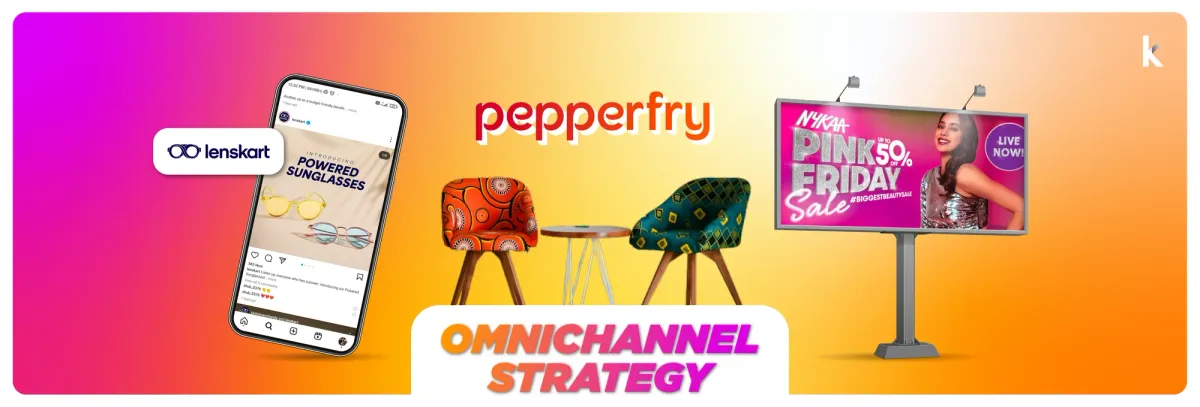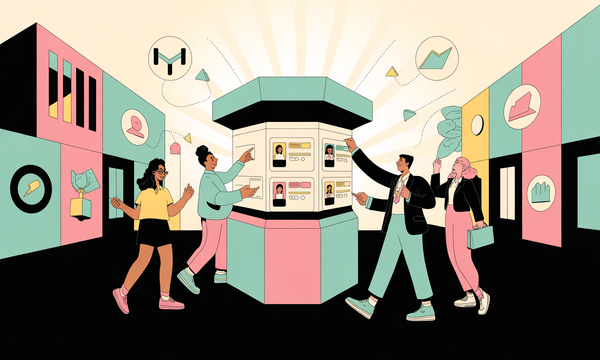These 9 mind-blowing hacks will catapult your consumer brand to omnichannel stardom

Omnichannel retail is a customer experience strategy that lets customers interact with your brand on their preferred channels, such as physical stores, online stores, mobile apps, social media, and more.
It provides a seamless, consistent, and personalised shopping experience across all channels by retaining customers' information as they switch between them. For example, a customer can browse a product online, add it to their cart, and then purchase it in-store without searching again.
In this blog, we'll unlock the secrets of omnichannel triumph, unveiling mind-blowing hacks that will catapult your consumer brand to new heights. These aren't just tips; they are the keys to unlocking unprecedented success.
The need to adapt omnichannel retailing for consumer brands
Omnichannel retailing is becoming more critical as customer expectations rise and technology advances.
"Despite the rise of digital sales platforms such as D2C websites, marketplaces, and social commerce, the predominant market share remains offline. If a consumer prefers buying shoes from a physical retail store, no amount of advertising will prompt them to click on an ad and make a purchase. Effectively altering a consumer's buying channel behaviour on a large scale without incurring disproportionate costs is a significant challenge. This struggle is evident in many consumer brands because they fundamentally attempt to shift channel behaviour. It's not solely about achieving product-market fit; it's equally crucial to establish product-market channel fit," emphasises Arindam Paul, Founding Member and Chief Business Officer at Atomberg Tech.
Online consumer brands can scale through omnichannel retailing by creating a loyal and satisfied customer base that values the convenience and quality of their shopping experience.
"One core thing about our GTM (Go-to-market strategy) is to think in a truly omnichannel way because if the consumer is omnichannel, you need to think omnichannel and be present everywhere and do all these activities", highlights Arindam Paul, Founding Member and Chief Business Officer at Atomberg Tech.
Benefits of omnichannel retailing
Omnichannel presence offers a myriad of benefits for online consumer brands, fostering a holistic and engaging customer experience:
Elevated customer satisfaction and retention
According to Aspect Software's study, positive omnichannel customer experiences drive brand loyalty and repeat purchases, with businesses using these strategies enjoying a remarkable 91% higher customer retention, outshining those with weaker strategy at 33%.
Enhanced customer insights and data utilisation
The diverse touchpoints of omnichannel presence empower online brands to comprehensively gather and analyse data, from web analytics to social media, email, SMS, and in-store transactions. This in-depth understanding enables tailored offerings and communications aligned with customer preferences.
Amplified sales and revenue streams
According to the International Data Corporation’s (IDC) report, omnichannel shoppers boast a 30% higher lifetime value than their counterparts who confine their shopping experiences to a single channel.
Strategy and best practices for online consumer brands to succeed at omnichannel retailing
Some of the best practices and hacks for online consumer brands to succeed at omnichannel presence are:
1. Define your customer personas and journeys
Online consumer brands should identify their target segments and map customer journeys across channels and devices. This can help them understand their customers' needs, preferences, motivations, pain points, and behaviours and design their omnichannel strategy accordingly.
2. Define your brand voice and tone
One of the critical aspects of omnichannel presence is to create a consistent and coherent brand identity across all channels and platforms. You should define your brand voice and tone and use them in all your communications, whether on your website, social media, email, SMS, or physical store.
An example of a brand that has a distinctive and consistent brand voice and tone is Zomato, an online food delivery and restaurant discovery platform in India.
Zomato uses a witty, humorous, and conversational tone in all its communications, whether on its website, app, social media, email, or SMS. Zomato's brand voice and style reflect its brand personality, values, and goals and resonate with its target audience, especially young and urban consumers.
3. Create visually consistent experiences
Another vital aspect of omnichannel presence is to create visually consistent experiences for your customers, no matter how they interact with your brand. You should use the same colour palettes, fonts, images, and design elements across all your channels and platforms. This can help you build customer trust and recognition and differentiate yourself from competitors.
An example of a brand that has created visually consistent experiences for its customers is Apple, a global technology company.
Apple's visual consistency throughout its channels helped it build customer trust and recognition and differentiate itself from competitors.
4. Optimise your online store for mobile
As more and more customers use their mobile devices to shop online, you should optimise your online store for mobile. You should ensure that your website, mobile app, or social media platforms are user-friendly, responsive, fast, and secure.
An example here is Nykaa. It ensures that its website, app, and social media platforms are user-friendly, responsive, fast, and secure for mobile users.
Nykaa also provides relevant and personalised content, offers, and recommendations based on the customer's context, behaviour, and preferences, such as location, browsing history, and purchase history.
5. Integrate your systems
To provide a seamless and smooth customer experience across channels, you should integrate your systems and tools, such as CRM, CMS, e-commerce platforms, analytics, and automation. This can help you collect and analyse data from multiple sources and touchpoints, such as web analytics, social media, email, SMS, and in-store transactions.
Starbucks integrates its CRM, CMS, e-commerce platforms, analytics, and automation to collect and analyse data from multiple sources and touchpoints.
It uses this data to understand its customers better and tailor its offerings and communications accordingly, such as personalised rewards, coupons, and suggestions.
6. Personalise your customer journey
You can use data and analytics to segment your customers based on their demographics, preferences, behaviour, and history.
You can then tailor your content, offers, and interactions to each segment and deliver them across their preferred channels and platforms.
Netflix, a global streaming service, uses data and analytics to segment its customers based on demographics, preferences, behaviour, and history.
It then tailors its content and interactions to each segment, delivering them across their preferred channels and platforms, such as websites, apps, emails, or TV.
Netflix's personalisation helps it increase customer engagement, loyalty, and retention and boost its conversions and revenue.
7. Leverage social commerce
You can use social media platforms to showcase your products, generate user-generated content, drive traffic to your online store or buy your products directly from social media without leaving the platform.
An example of a brand that has leveraged social commerce is FableStreet. It allows its users to buy products directly from social media without leaving the platform.
8. Integrate offline and online channels
You can use QR codes, NFC, RFID, or AR/VR to connect offline and online channels and create a seamless and immersive customer experience.
An example of a brand that has integrated its offline and online channels is Lenskart, an online eyewear retailer in India. Lenskart uses technologies such as QR codes, NFC, RFID, or AR/VR to connect its offline and online channels and create a seamless and immersive customer experience.
Lenskart also uses tools such as click-and-collect, curbside pickup, or same-day delivery to offer more options and convenience to its customers. Lenskart's integration helps it bridge the gap between the physical and digital worlds and enhances customer satisfaction and loyalty.
9. Measure and improve your performance
Measure and enhance your omnichannel performance using metrics and KPIs that reflect their goals and objectives. Some standard metrics and KPIs are customer satisfaction, retention, lifetime value, conversion rate, average order value, and revenue.
You must also use feedback and data to identify and address gaps or issues in your omnichannel strategy and continuously improve customer experience.
What are some common mistakes to avoid while scaling through omnichannel retailing?
"Until you are very sure about SKU level PMF in ecom or D2C, do not launch it offline because rolling it back is very painful offline. Because Omnichannel is a flavour today, people think, let me open out all the geographies & I'll see an immediate spike in revenue. Many brands are struggling because offline doesn't give you a second chance as it's challenging to relaunch in that market," highlights Arindam Paul, Founding Member and Chief Business Officer at Atomberg Tech.
Some common mistakes to avoid while planning and executing your omnichannel presence are:
Inability to connect the dots
You might need help to integrate data from different channels to create a seamless customer journey, leading to your customers having to repeat their information or preferences across channels.
To avoid this, marketers should use a unified platform to collect and analyse data from multiple sources and touchpoints and provide a single view of the customer.
Ineffective content strategy
Content is pivotal to the success of an omnichannel marketing strategy. An ineffective content strategy is bound to make the campaign a failure.
You should create relevant, personalised, engaging content for each channel and customer segment. You should also use the right tone, voice, and format for each channel and ensure the content is consistent and coherent across all channels.
Lack of attribution
To understand how different campaigns and channels are performing, you need to know the source and impact of each interaction.
However, many marketers need help attributing the results to the proper channels and touchpoints, especially when customers switch between online and offline channels.
To avoid this, marketers should use advanced analytics and attribution models to track and measure the customer journey across channels and devices and optimise their budget and strategy accordingly.
Poor customer service
Customer service is integral to omnichannel presence, as it can make or break the customer experience.
However, many brands fail to provide consistent and seamless customer service across channels, leading to customer frustration and dissatisfaction.
To avoid this, you should ensure that their customer service agents can access the customer's history and preferences and communicate with them through their preferred channel. You must consider investing in self-service options like chatbots, FAQs, and forums to help customers resolve their issues quickly and conveniently.
Human error
Human error is inevitable in any presence campaign, but it can have severe consequences in omnichannel marketing, where a single mistake can affect multiple channels and touchpoints.
For example, a broken link, a typo, or a wrong setting can ruin the customer experience and the brand's reputation. To avoid this, you should have thorough systems and steps, such as quality checks, testing, and monitoring, to prevent and detect any errors. You should also have a contingency plan to handle any issues or crises.
In a world where customer expectations are soaring, the key to online consumer brand success is mastering the art of omnichannel retailing. As showcased by giants like Zomato, Nykaa, and Lenskart, the game-changing benefits are crystal clear: enhanced customer loyalty, skyrocketing satisfaction, and a substantial boost in revenue. These proven best practices, from defining customer personas to seamlessly integrating offline and online channels, offer a roadmap for brands seeking to scale their presence. Remember, the future of online retail is omnichannel, and those who embrace it now are destined to thrive in the dynamic landscape of customer-centric commerce.




